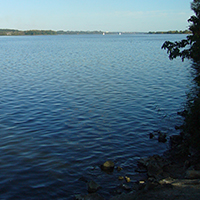Microcosm on a bottle: experimental tests on the colonization of plastic and glass substrates in a retention reservoir
Micro- and macroorganisms in a eutrophic reservoir

Submitted: 30 December 2019
Accepted: 16 March 2020
Published: 27 March 2020
Accepted: 16 March 2020
Abstract Views: 1706
PDF: 464
HTML: 34
HTML: 34
Publisher's note
All claims expressed in this article are solely those of the authors and do not necessarily represent those of their affiliated organizations, or those of the publisher, the editors and the reviewers. Any product that may be evaluated in this article or claim that may be made by its manufacturer is not guaranteed or endorsed by the publisher.
All claims expressed in this article are solely those of the authors and do not necessarily represent those of their affiliated organizations, or those of the publisher, the editors and the reviewers. Any product that may be evaluated in this article or claim that may be made by its manufacturer is not guaranteed or endorsed by the publisher.
Similar Articles
- Fabien Bourinet, Orlane Anneville, Hilaire Drouineau, Chloé Goulon, Jean Guillard, Alexandre Richard, Synchrony in whitefish stock dynamics: disentangling the effects of local drivers and climate , Journal of Limnology: Vol. 82 (2023)
- Selene Babini, Luciana Cibils Martina, Elisa Luque, Noemi Gari, Nancy Salas, Adolfo L. Martino, Anuran larvae diet from agroecosystem’s ponds: environmental quality and implications for their populations , Journal of Limnology: Vol. 76 No. 1 (2017)
- Carmen Gabaldón, Miloslav Devetter, Josef Hejzlar, Karel Šimek, Petr Znachor, Jiří Nedoma, Jaromir Seda, Repeated flood disturbance enhances rotifer dominance and diversity in a zooplankton community of a small dammed mountain pond , Journal of Limnology: Vol. 76 No. 2 (2017)
- Oscar Wembo Ndeo, Torsten Hauffe, Diana Delicado, Alidor Kankonda Busanga, Christian Albrecht, Mollusk communities of the central Congo River shaped by combined effects of barriers, environmental gradients, and species dispersal , Journal of Limnology: Vol. 76 No. 3 (2017)
- Cuilin Hu, Shengrui Wang, Longgen Guo, Ping Xie, Effects of the proximal factors on the diel vertical migration of zooplankton in a plateau meso-eutrophic Lake Erhai, China , Journal of Limnology: Vol. 73 No. 2 (2014)
- Andreu Castillo-Escrivà, Ángel Baltanás, Antonio Camacho, David J. Horne, Joan Lluís Pretus, Francesc Mesquita-Joanes, IMOST: a database for non-marine ostracods in the Iberian Peninsula, the Balearic Islands and Macaronesia , Journal of Limnology: Vol. 82 No. s1 (2023): Georeferenced freshwater biodiversity data
- Pietro Volta, Nicoletta Riccardi, Rosaria Lauceri, Mauro Tonolla, Discrimination of freshwater fish species by Matrix-Assisted Laser Desorption/Ionization- Time Of Flight Mass Spectrometry (MALDI-TOF MS): a pilot study , Journal of Limnology: Vol. 71 No. 1 (2012)
- Monica Pinardi, Gary Free, Beatrice Lotto, Nicola Ghirardi, Marco Bartoli, Mariano Bresciani, Exploiting high frequency monitoring and satellite imagery for assessing chlorophyll-a dynamics in a shallow eutrophic lake , Journal of Limnology: Vol. 80 No. 3 (2021): Celebratory Issue - 80th Anniversary of the Journal of Limnology
- Eliana A. Panarelli, Daryl L. Nielsen, Aleicia Holland, Cladocera resting egg banks in temporary and permanent wetlands , Journal of Limnology: Vol. 80 No. 1 (2021)
- Diego de Jesus Chaparro-Herrera, Sarma Nandini, S.S.S. Sarma, Effect of water quality on the feeding ecology of axolotl Ambystoma mexicanum , Journal of Limnology: Vol. 72 No. 3 (2013)
<< < 5 6 7 8 9 10 11 12 13 14 > >>
You may also start an advanced similarity search for this article.

 https://doi.org/10.4081/jlimnol.2020.1958
https://doi.org/10.4081/jlimnol.2020.1958





